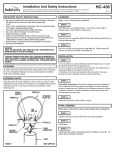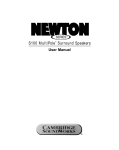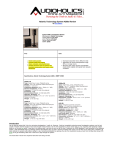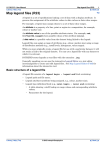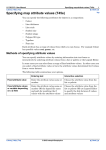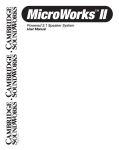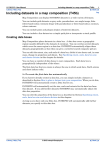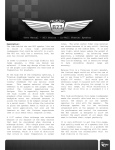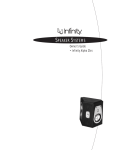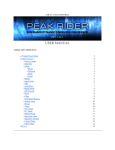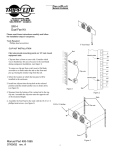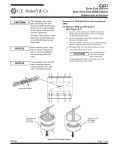Download S300 & S200 manual
Transcript
™ S300 and S200 MultiPole Surround Speakers ™ User Manual ® 2 INTRODUCTION Thanks for choosing a Newton Series surround loudspeaker. The S200 and S300 both feature the finest drivers, precision internal crossover circuitry and an elegant enclosure design. The Product Development Team at Cambridge SoundWorks believes there is no better combination of audiophile-level attention to detail and reasonable cost. AFTER UNPACKING Store the shipping carton and packing material for future use and transport. CONTENTS S300 and S200 1. Two loudspeakers 2. Two No. 10 screws and plastic wall anchors 3. Eight rubber feet INSPECTING FOR DAMAGE Examine the speaker system carefully for shipping damage. If there is any, do not install or use the system. Return the speaker to the store where you made the purchase or call Cambridge SoundWorks at 1-800 FOR-HIFI (1-800-367-4434) for assistance. 3 POSITIONING YOUR SPEAKERS SPEAKERS ARE LABELED "LEFT" OR "RIGHT" The following suggestions assume you have some flexibility regarding where you place your speakers. A. Don’t be too concerned if your situation and listening S200 environment dictate the speakers’ position. As long Multipole“ Surround Loudspeaker as each surround speaker is on the left or right half Newton, Massachusetts USA 00000000 RIGHT — 8 Ohms + of the listening space, the speakers are will provide convincing, lifelike sound. Back of Speaker Mounting: The typical way to position surround speak- B. ers is to wall-mount them on a protruding screwhead. Other methods are to place them on short shelves, to mount them on short swivel brackets, or to install them on floor stands. Notice: The speakers are marked LEFT and RIGHT. Most often, the speakers will be wall-mounted with the MultiPole switch panel facing down. In this case, Stand Mounted Switch Facing Upward mount the LEFT speaker on the listener’s left side and the RIGHT speaker on the listener’s right side (see C. diagram A). RIGHT SPEAKER You may need to invert the speakers to provide LEFT SPEAKER WALL MOUNTED - SWITCH FACING DOWNWARD access to the MultiPole switch (such as when placing them on small support shelves or floor stands). In this 7 Ft. case, reverse the speakers’ left/right positions (see diagram B). Front to Back placement: Place each surround speak- 4 Ft. er to the left or right of the listening area. Try to position the speakers within two feet of a line centered on your listening postion (see diagram C). Wall Mounted Height Placement Height: Place each speaker at least four feet above the floor, up to seven feet above the floor (see D. diagram D). 2 FEET 2 FEET Note: It is not critical that the left and right speakers be the same distance from the front speakers or equal heights. If you don’t have walls on both sides of your listening area, try to avoid placing both surround speakers on a wall behind the listening postion. Sonically, it’s still better to place one speaker on a side wall and one speaker on a rear wall. This provides better separation than two speakers on a wall behind the listeners. CENTER LINE OF LISTENING POSITION Front to Back Placement of Surround Speakers 4 SPEAKER MOUNTING Hang the S200 or S300 directly on a wall: Install a No.10 screw in the wall so that its screwhead protrudes about 3/8 inch. Cambridge SoundWorks supplies screws and plastic anchors for your convenience, but it is the installer’s responsibility to insure the screw is securely mounted. Apply the soft, self-adhesive feet to back of the speakers. The feet protect the finish of the speakers or the surface and improve stability if the surface is not perfectly flat. USE THIS KEYHOLE SLOT TO HANG THE SPEAKER FROM A SCREWHEAD. (SIDE VIEW) USE THE THREADED INSERT TO ATTACH A SWIVEL BRACKET. S200 Multipole“ Surround Loudspeaker Newton, Massachusetts USA 00000000 RIGHT — 8 Ohms + SWITCH (BACK VIEW) APPLY SELF-ADHESIVE FEET TO BACK OF SPEAKERS. 5 A small, purpose-built shelf can be used instead of BOTTOM OF SPEAKER hanging the speakers from a screwhead. In this case, we recommend you apply the soft, self-adhesive feet to bottom of the enclosures. The feet protect the finish of the speakers or the surface and improve stability if the surface is not perfectly flat. Apply the feet to the surface of the speaker opposite the MultiPole switch, in the pattern shown. Using The Speakers On A Stand Cambridge SoundWorks has floor-stands available for the S200 and S300. APPLY SELF-ADHESIVE FEET TO BACK OF SPEAKERS. The speakers mount to the stand with the MultiPole switch on top. For this reason, the positions of the ATTACHING SPEAKER TO STAND speaker should be reversed (the speaker marked left should be placed on the listener’s right side and — 8 Ohms + 00000000 Multipole“ Surround Loudspeaker Newton, Massachusetts USA S200 Mount the surround speaker to a stand by screwing the stand’s fastener into the surround speaker’s threaded insert. SWIVEL BRACKET FOR NON-VERTICAL OR CEILING MOUNTING NON-VERTICAL/CEILING MOUNTING RIGHT SPEAKER SWITCH RIGHT vice versa). LEFT SPEAKER SWITCH Swivel-brackets (available separately) can be used to attach the surround speakers to a wall that isn't vertical, or to the ceiling. 6 About MultiPole Technology MultiPole Modes The MultiPole capability of your S200 and S300 lets you better enjoy different types of surround programs at their best. The descriptions that follow assume you will position your surround speakers to the left and right of the listening area and not directly behind it. Dipole Mode: This mode provides everyone in the listening space with enveloping surround. Most sound is projected sideways (to the front and rear of the room), while little is directed at the listeners (see Dipole in the Multipole Modes diagram). As a result, the sound is well mixed with room reflections, following longer paths. In Dipole mode, a listener can be closer to one surround speaker than the other and still hear both surround speakers. This characteristic makes it ideal for smaller rooms, where a listener may be closer to one surround speaker than the other. Dipole mode is ideal for use with synthesized surround decoding modes; the choices on your decoder labeled “Hall,” “Theater,” “Church,” or similar names. Also, use it for Dolby Surround programs (the predecessor to Dolby Digital and the format supported by stereo TV programs with surround encoding). Dolby Surround has a monaural surround channel which is split between the two surround speakers. Dipole mode’s dispersion pattern prevents this channel from “collapsing” towards the closer surround speaker. (S300 only) Bipole Mode: This mode “fills in the middle” compared to Dipole mode. Each surround speaker projects approximately equal amounts of sound to the sides and at the listening area (see Bipole in the Multipole Modes diagram). This makes it easier to hear effects occurring between the left and right surround speakers. Dolby Digital’s separate left and right rear channels make this possible. The more Dolby Digital program material you listen to, the more you will benefit from Bipole mode. In larger listening spaces, Bipole mode can even rival Dipole mode on non-Dolby Digital program sources. Monopole Mode (S300 only): In this mode, the S300 substitutes a dedicated, front panel-mounted, direct-radiating two-way system for the front and rear surround drivers. This precise system directs sound mostly at the listening area, like the front three speakers (see Monopole in the Multipole Modes diagram). For centrally located listeners, this mode provides the most precise sonic imaging, both front-to-rear and side-to-side. Use it for Dolby Digital programs with abundant multichannel sound effects. speakers positioned with switch undernea 7 PREPARE THE SPEAKER WIRE Use at least 18 gauge speaker cable for short runs Strip off 1/2" (under 15 feet). Use 16 gauge or heavier speaker cable for longer runs. 1. Determine how long the speaker cable should be for each speaker. Cut the speaker cable into the appropriate lengths. 2. Strip 1/2 inch of insulation from the two individual conductors in the speaker cable. Twist the exposed Twist Bare Wire strands of bare wire together 3. Attach any connector plugs (like banana plugs) at this time. 4. Determine which conductor you will use to connect the positive terminals of the amplifier and speaker together. One of the two conductors of a speaker cable can usually be distinguished by printing or a ridge on the insulation. Some times the metal of the conductors has two different colors. Make The Connections: SPEAKER WIRE CONNECTION S200/S300 1. Unscrew the speaker’s red and black connector knobs to expose the holes in their threaded shafts. 2. Insert the stripped end of one cable’s “indicated” conductor into the speaker’s red (+) connector. S200 Hand-tighten the knob to secure the connection. Multipole“ Surround Loudspeaker Newton, Massachusetts USA 00000000 Make sure no stray strands of wire are exposed. RIGHT If you are using a cable connector plug, connect it according to its instructions 3. Repeat the procedure for the cable’s other conductor and the speaker’s black (–) connector 4. Connect the other speaker cable’s conductors to the other speaker. 5. Connect the opposite ends of the speaker cable to the speaker outputs of your receiver. Remember to observe channel and polarity (Left Positive, Left Negative, Right Positive, Right Negative). 8 — 8 Ohms + SPECIFICATIONS Speaker Size Setting in Dolby Digital Decoders S200: The S200 and S300 include internal high-pass Weight: 5 pounds each Dimensions: 7"H x 11"W x 5 3/4"D networks that prevent them from responding to low- S300: frequency signals below their operation range. Dimensions: 7"H x 11"W x 5 3/4"D When connecting either speaker to a Dolby Digital Weight: 6 pounds each decoder, set the decoders rear channel size setting to SMALL. If there is a crossover frequency choice, set The S200 and S300 can be safely used with any sur- at 100 Hz or lower. round receiver rated above 25 watts per channel. There is little advantage gained in using more power than 100 watts per surround channel, but amplifiers above this power rating can be used so long as the receiver is not operated at distorted levels. Warning About Excessive Amplifier Distortion Operating a receiver (of any power rating) beyond its maximum undistorted output level creates distortion— added high-frequency sound not part of the musical program. Distortion dramatically increases the internal operating temperature of a loudspeaker and will eventually cause the speaker’s failure due to burned or melted internal parts. While Cambridge SoundWorks includes the most heat-tolerant parts commensurate with good acoustic design, the speaker’s Limited Warranty against defects in materials or workmanship does not apply to parts that fail from long-term operation at very high temperatures Enclosure Cleaning The speaker enclosures can be cleaned with a window-cleaning product. Use a soft, lint-free cloth only. Avoid spraying any cleaner on the grille panels. Brush or vacuum the grille panels if dust accumulates on them. 9 10 P81-1700 Rev A












